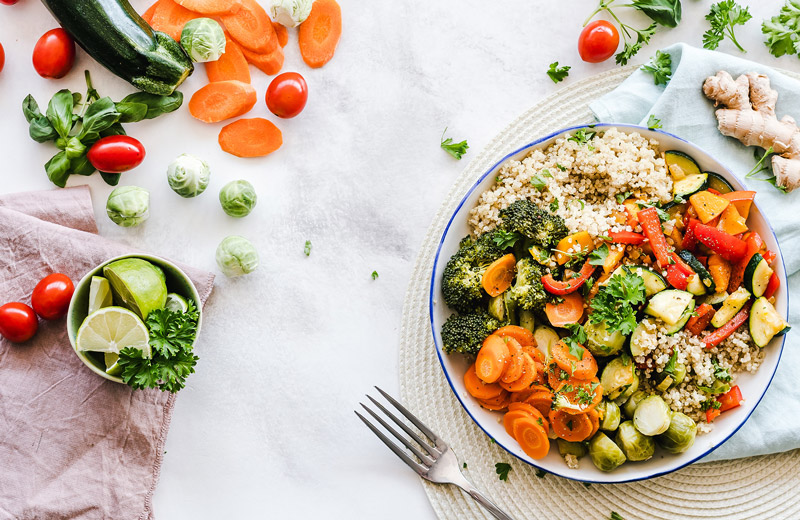Personal Trainer
The 4 Fundamentals of Healthy Living
- Increasing physical activity
- Eating nutritious food more often
- Getting more, better quality sleep
- Managing and reducing stress

How to Increase Daily Physical Activity
Physical activity refers to any movement of the body. Conversely, exercise refers to planned, structured and intentional movement. All exercise is physical activity, but not all physical activity is exercise. Which one do you think offers benefits to your health and wellness? Trick question – they both do!
Much of the research out there is on physical activity, not exercise. This means that movement doesn’t always have to be structured to be beneficial.
Exercise is typical weight training in a gym, where you’re keeping track of the sets and reps. Another example may be doing intervals on the treadmill or stationary bike. Even playing a team sport is exercise.
Physical activity encompasses all movement. This includes walking your dog, gardening, or biking to work instead of driving. As you work to increase your daily physical activity levels, consider these guidelines:
Think Positive
Start Small
Find Movement You Enjoy
Incorporate Aerobic and Strength Activities

How to Improve Your Nutrition
In a world of crash dieting and health ‘hacks’, there is constant pressure to try the latest quick fix. In truth, there are no quick fixes when it comes to healthy eating. Making healthier choices will lead to more benefits than a fad diet ever could.
Here are some simple nutrition tips to get you started:
Look for Little Lists
For the most part, eat foods with no ingredient list. In other words, opt for whole food options instead of processed. There’s no need for an ingredient list on fresh veggies, fruit, meat and grains!
If you do want to include some processed foods, choose those with shorter lists. These foods are often less processed and include less added sugar, fat, and salt.
Stay Hydrated
More than half of our body is water, so it’s no surprise that we need a lot of it! Adequate hydration can improve heart health and help manage pain.
Strive to drink about ½ an ounce of water per pound of bodyweight. If you weigh 200 pounds, aim to drink at least 100 ounces, or three liters, of water per day. For more tips on how to stay hydrated, check out our Hydration Series in our Healthy Living Library.
Get Enough Protein
Most of the foods that are quick, convenient, and accessible are high in carbohydrates and fat. This means you may need to be more mindful of your protein intake.
Protein is critical for maintaining our muscle mass as we age. Strive to eat at least 0.5 grams of protein per pound of bodyweight per day. So, if you’re 200 pounds, you would aim to eat 100 grams of protein each day. If you exercise regularly, increase the intake rule to 0.75 grams per pound of bodyweight to adequately fuel your muscles. This would make the daily protein intake 150 grams for someone who is 200 pounds.
To learn more about how to eat healthier, including a breakdown of each macronutrient, check out this article: How to Eat Healthier: Macronutrients, The Plate Method, and Eating Behaviour

How to Improve Your Sleep
As renowned scientist and sleep expert Dr. Matthew Walker says, “If sleep does not provide a remarkable set of benefits, then it’s the biggest mistake the evolutionary process has ever made.”
In other words, for our ancestors, being physically vulnerable for almost 8 hours per day was risky business when the threat of predators was much more real. This highlights the importance of sleep – if it didn’t benefit our wellbeing, we would’ve adapted to need less!
Here are a few ways to optimize your sleep:
Create a Sleep Schedule
Do your best to go to bed and wake up at the same time, or at least within the hour. Even on weekends! I know it’s tempting to sleep in, but your body will thank you come Monday morning when you’re still well-adjusted to your typical schedule.
Design a Winding-Down Routine
Start a routine that helps you relax before bed. This will take trial and error, so be mindful of the activities you choose before bedtime. For some, this routine may begin in the afternoon, by avoiding caffeine after 12 pm. Closer to bedtime, try to avoid screens that emit blue light. Instead try reading a book, chatting with your partner, doing some light yoga, or taking a shower or bath.
Keep it Cool and Dark
To sleep, our core body temperature must drop by about one degree Celsius. This means that a room that’s too warm will make it hard to fall asleep. Aim for bedroom temperatures around 18 to 19 degrees Celsius.
Darkness is just as important. A dark room triggers your body’s release of the hormone melatonin, which helps us to feel tired and fall asleep. Bright lights and screens can inhibit this process.
For a more ways to improve your sleep and maximize your nightly snooze, check out our Sleep Series in our Healthy Living Library.

How to Improve Mental Wellness
Mental health is a complex topic, and I am by no means an expert in this area. But there are simple things you can do better your mind.
Check out some ideas below:
Be Present
Life can get hectic, but don’t let that stop you from enjoying the moment. You only really have the present moment, that’s all you can affect. If you have trouble staying present, try techniques like journaling or meditation. For a great guided mindfulness practice, including a follow-along journal session, check out our Mindfulness Series in our Healthy Living Library.
Appreciate the Little Things
Take note of the little things, whether it’s a delicious new recipe, or a good conversation with a friend. It can be easy to get caught up in saving for that new car or striving towards a promotion at work. Remember that those ‘grand’ moments are only a small fraction of your life. What does the other 99% look like?
Spend Time in Nature
More and more research points to the relationship between spending time outdoors and a reduction in stress. With many of us sitting indoors and staring at screens for much of the day, this has become even more important. Try to add a nature walk into your weekly routine.
